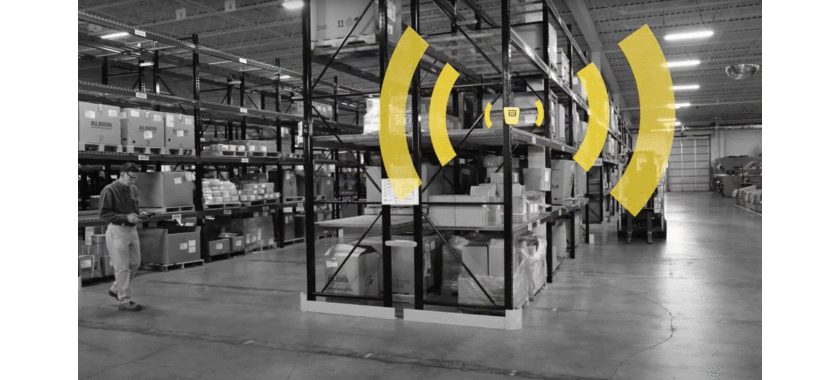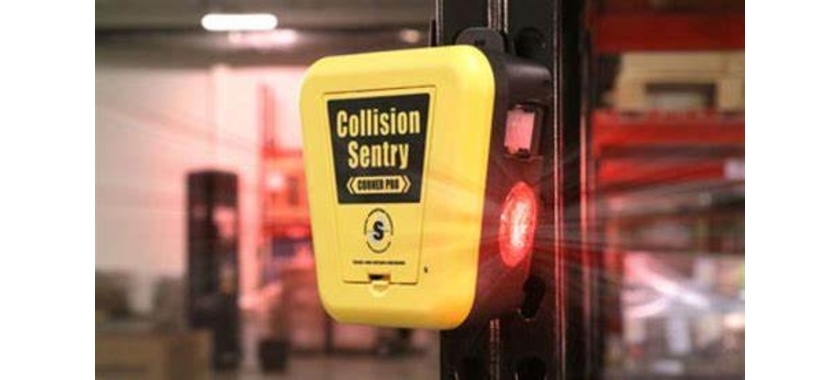

Blind corner intersections are a prime spot for accidents in any industrial setting – accidents that can result in damage to equipment, the facility and most importantly to people. Collision Sentry Corner Pro works to prevent accidents at blind corners by sending both an audio and visual alert to warn of approaching trac. Collision Sentry Corner Pro helps create a safer working environment in areas where forklift trac and pedestrian trac intersect.
Advantages
- Protect people from injury
- Prevent equipment damage
- Prevent damage to the facility
- Increase and maintain productivity by avoiding delays due to accidents
Features
- Loud enough to be heard from within the corner zone and set it apart from other background noises
- Detection zone 20-25 feet in each direction
- Flashes warning ONLY when motion is detected on both sides of the corner
- Pre-set and ready to use
- Lens concentrates and increases beam’s intensity
- Optimal installation height is 7 to 9 feet on the upright
- Self Powered
Forklift Collision Sensors: A Safety and Efficiency Innovation in Warehouses
Safety and reduction of operational risks are the prime concerns in the fast-paced warehouse and logistics environment. The forklift collision sensor system is one such solution that is changing the scenario of workplace safety. Forklifts are widely used to handle heavy materials, and operation in confined spaces always poses a risk of accidents. Forklift collision sensors are an essential element in enhancing safety, preventing accidents, and promoting efficiency. In this article, we will discuss the significance of forklift collision sensors, how they work, and their benefits to businesses that value workplace safety.
What is a Forklift Collision Sensor?
A forklift collision sensor is a high-tech safety feature installed on forklifts to prevent collisions and minimize accidents. These sensors use advanced technologies like radar, ultrasound, or LIDAR to detect obstacles in the path of the forklift. In case an obstacle is detected, the system sends an audible or visual warning to the forklift operator. In some cases, the speed of the forklift might be automatically reduced or even the brakes may be applied in order to avoid a collision.
Businesses can significantly reduce the possibilities of accidents and injuries if they integrate forklift collision sensors into their operations. The sensors provide an extra layer of protection, as the real-time data they gather will be transmitted to the operator, and it can enhance the response time of the vehicle to unexpected obstacles.
Forklift Collision Sensors and Warehouses
Warehouses can be very busy places; there is a lack of space, and the chances of accidents are always there. The introduction of forklift collision sensors has brought a significant improvement in safety standards. Forklifts are involved in many warehouse tasks, such as loading and unloading goods, stacking pallets, and transporting materials from one area to another. However, the sheer size of forklifts and the speed at which they operate can make it difficult for operators to detect obstacles in their path, leading to potential collisions.
Forklift collision sensors could reduce the risk of accidents drastically as well as enable better navigation of tight spaces safely. Besides, the sensor helps to minimize the extent of damage resulting from accidents on either the forklift, goods, or personnel. The costs that might arise in case of accidents far outweigh the cost of a forklift collision sensor system and, thus, an investment that would be prudent to any business.
How Forklift Collision Sensors Work
Typically, forklift collision sensors use a combination of technologies, including proximity sensors, ultrasonic sensors, or cameras. These systems are set up to constantly monitor the environment around the forklift and alert the operator to obstacles detected.
1.Proximity Sensors: These sensors measure the distance of objects from the forklift. Whenever an object comes within a predetermined range, the sensor activates an alarm, providing the operator with time to act.
2.Ultrasonic Sensors: These sensors measure distances by emitting sound waves that bounce off objects along the path of the forklift. By measuring the return of the sound waves, the sensor calculates the distance to the object and alerts the driver if an object is too close.
3.Cameras and Vision Systems: Forklift collision sensors can be equipped with cameras or vision systems that deliver real-time images of the environment. These systems can be supplied with AI-driven software that interprets the images and alerts the operator to possible hazards.
Forklift collision sensors use a combination of technologies, which can give total protection and prevent accidents in real time.
Benefits of Forklift Collision Sensors
The introduction of forklift collision sensors has a number of key benefits for businesses, operators, and even customers. The following are the primary advantages:
- Worker Safety Enhancement
One of the most obvious reasons why forklift collision sensors are important is enhanced security. Forklift-related injuries and fatalities can be heavy and even fatal. Moreover, reducing the chances of accidents greatly contributes to the security for forklift drivers alone, pedestrians, other people and even vehicles in a storehouse. In stores which contain heavy machinery, for instance, a forklift collision sensor system will easily separate a minor accident from a big time disaster.
- Reduced Operational Downtime
Forklift accidents often result in damaged trucks, which means downtime for repair and maintenance. Forklift collision sensors reduce this risk by preventing accidents that could damage the forklifts. This, in turn, keeps operations running smoothly and reduces costly downtime. With forklifts running, businesses can maintain productivity and efficiency in their warehouses.
- Savings on Repairs and Insurance
Forklift accidents can result in costly repairs and higher insurance rates. The installation of forklift collision sensors helps reduce the risk of forklift accidents, thus minimizing collisions. This can result in reduced repair and maintenance costs as well as a lower number of insurance claims. The cost of installing forklift collision sensors will be repaid over time by saving money on these factors.
- Safety Compliance
Workplace safety is under strict rules. Non-compliance with those requirements can invite penalties and liabilities in terms of litigation and damage to reputation. A majority of regulatory commissions now have mandates requiring that businesses must put safety in place through installation of forklift collision sensors among others. Businesses, therefore will be ensuring health and safety regulations compliance hence avoid hefty fines and liabilities.
- Efficiency and Productivity Enhancement
Forklifts equipped with collision sensors are faster and more accurate. The sensors provide the operators with an easier way to navigate quickly in the warehouse without being so cautious of potential obstacles. This is because it increases the operation efficiency, reduces loading and unloading time, and makes the overall productivity much higher.
How Forklift Collision Sensors Contribute to Sustainable Practices
In addition to the contribution in safety and efficiency, sensors for forklift collisions offer a means to reach their sustainability goals. Through averting accidents, a firm can reduce its environmental footprint because damaged goods and packaging materials that would otherwise be discarded need not be. Furthermore, using forklift collision sensors minimizes the maintenance requirement and repair work, hence adding to the life cycle of the forklift equipment. This means less waste and resources devoted to replacing damaged machinery and equipment.
Selecting the Right Forklift Collision Sensor System
In the selection of a forklift collision sensor system, the following factors must be taken into consideration to ensure it serves the operational needs:
- Type of Sensors: Assess the type of technology the sensor uses, such as ultrasonic, radar, or vision systems, and opt for the one that is best suited for your warehouse environment.
- Range and Sensitivity: The sensor must have a good detection range that can detect obstacles in time. It should be sensitive enough to detect big as well as small obstacles.
- Integration with Existing Systems: Select a system that integrates well with your current forklift models and other safety systems already in place.
- Maintenance and Support: The manufacturer should provide support and maintenance services to ensure the system is functioning effectively over time.
Conclusion
The use of forklift collision sensors in warehouses and logistics operations is no longer a luxury but a necessity. These sensors help create a safer working environment, improve operational efficiency, and reduce costs associated with accidents and repairs. Whether you are in a large warehouse operation or a small logistics company, installation of forklift collision sensors is a step up in protecting your workforce as well as improving your bottom line. Investment in these advanced features will undoubtedly bring back ample returns in the form of reducing accidents, enhancing productivity and long-term cost savings. In today’s increasingly competitive business world, smart investments like forklift collision sensors are what forward-thinking businesses need.

